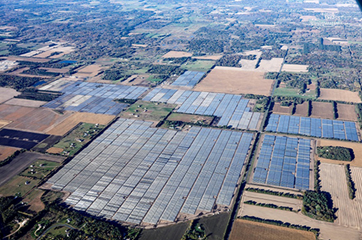 Loading... Please wait...
Loading... Please wait...Products
- Solar Panels
- Solar Panel Kits
- Solar Generators
- Inverters
- Inverter Monitoring
- Inverter Accessories
- Balance of Systems
- Racking and Mounting
- Rails
- Flashings
- Splice Kits
- Stopper Sleeves
- Conduit Mounts
- Attachments
- Brace Assembly
- Base Mount
- Brackets
- Bolts
- Clamps
- Caps
- L-Feet
- Washers
- Skirt
- Lugs
- Tilt Legs
- Hooks
- Stand-Offs
- Ballast Bay
- Top of Pole Mount
- Side of Pole Mount
- Flush Mount Kits
- Ground Mount Kits
- Roof Mount Kits
- Hardware Packages
- Wire Management
- Batteries
- Battery Accessories
- Charge Controllers
- Tools and Supplies
- View All Products
Solaris Blog - Utility Solar System
Utility Scale Solar Installations in the United States
Posted by Brandi Casey on 29th Mar 2017

The oftentimes cold state of Michigan is not the first state that one thinks of when they hear the word solar. However, that stigma did not stop Michigan from opening the North Star Solar Farm in December of 2016. The solar plant has the capacity to generate up to 100 megawatts of electricity, enough to power 20,000 homes with average energy usage. The system is currently producing power at a cost of 6 cents per kilowatt, on par or lower than traditional utilities. They will soon be joined with their neighbor Wisconsin who is breaking ground on a 100-megawatt system of their own, scheduled to be finished later this year.
Utility scale solar power plants have been growing exponentially over the last seven years, on par with the 85% drop in solar equipment cost. A price drop that has been beneficial for home, business and utility owners and has caused a dramatic increase in solar system installation.
According to the Solar Energy Industries Association (SEIA) there are up to 18 gigawatts of upcoming utility-scale projects under contact. In order get a contract for a solar utility scale project, utilities must expect their project to be completed in the next two to three years, and have a Power Purchase Agreement. The U.S. Department of Energy’s SunShot Initiative engages in research and development projects with the express purpose of making solar energy costs competitive with conventional sources of electricity, with the goal of 6 cents per kilowatt. The initiative partnering with utilities projects like the North Star Solar Farm, have met that goal ahead of schedule.
The implementation of utility scale applications across the United States is another positive indicator that solar will not be phased out anytime soon. Although numerous states are worried about potential political direction, states such as Georgia show that they have motivation to drive forward without government incentives an intervention. Georgia does not currently have any government backed rebates or incentives to help offset the cost of solar, however the state has broken ground on their own utility scale project and continues to grow in home solar system installations. As technology continues to grow and drive down solar costs, rebates and incentives although a motivator, are not a necessity to establish growth.
Utility scale programs offer a great deal of incentives for homeowners who cannot afford the cost of solar to opt in on the alternative energy source. Many large-scale utility companies such as Xcel Energy have noticed the trend and set the bar high for their own utility costs, requiring solar power plants to source a percentage of their energy from a renewable power source from solar to wind and beyond. Regardless of political environment, the benefit and durability of solar energy has been wide spread and does not show any signs of stopping. As Michigan and Wisconsin has proven, although a geographical area may not be considered ideal, you can still utilize solar to benefit consumers and the environment to pave the way for a greener future.



